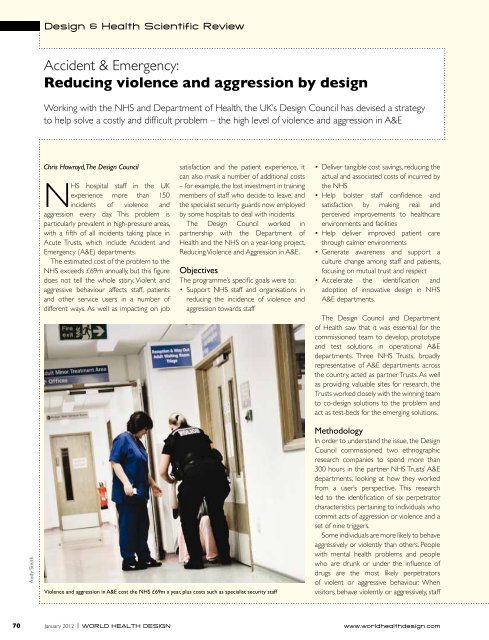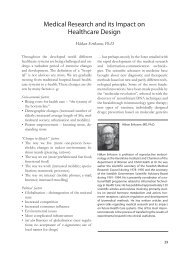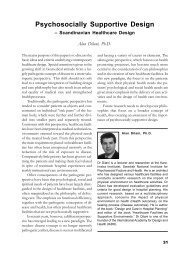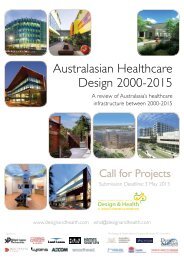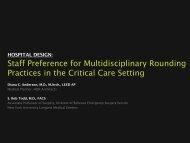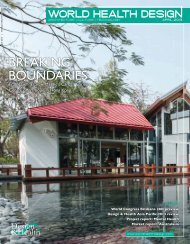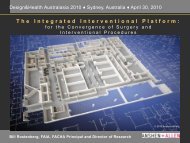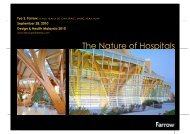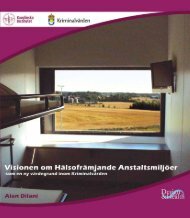RESTORATIVE SpAcE - the International Academy of Design and ...
RESTORATIVE SpAcE - the International Academy of Design and ...
RESTORATIVE SpAcE - the International Academy of Design and ...
Create successful ePaper yourself
Turn your PDF publications into a flip-book with our unique Google optimized e-Paper software.
<strong>Design</strong> & Health Scientific Review<br />
Accident & Emergency:<br />
Reducing violence <strong>and</strong> aggression by design<br />
Working with <strong>the</strong> NHS <strong>and</strong> Department <strong>of</strong> Health, <strong>the</strong> UK’s <strong>Design</strong> Council has devised a strategy<br />
to help solve a costly <strong>and</strong> difficult problem – <strong>the</strong> high level <strong>of</strong> violence <strong>and</strong> aggression in A&E<br />
Chris Howroyd, The <strong>Design</strong> Council<br />
NHS hospital staff in <strong>the</strong> UK<br />
experience more than 150<br />
incidents <strong>of</strong> violence <strong>and</strong><br />
aggression every day. This problem is<br />
particularly prevalent in high-pressure areas,<br />
with a fifth <strong>of</strong> all incidents taking place in<br />
Acute Trusts, which include Accident <strong>and</strong><br />
Emergency (A&E) departments.<br />
The estimated cost <strong>of</strong> <strong>the</strong> problem to <strong>the</strong><br />
NHS exceeds £69m annually, but this figure<br />
does not tell <strong>the</strong> whole story. Violent <strong>and</strong><br />
aggressive behaviour affects staff, patients<br />
<strong>and</strong> o<strong>the</strong>r service users in a number <strong>of</strong><br />
different ways. As well as impacting on job<br />
satisfaction <strong>and</strong> <strong>the</strong> patient experience, it<br />
can also mask a number <strong>of</strong> additional costs<br />
– for example, <strong>the</strong> lost investment in training<br />
members <strong>of</strong> staff who decide to leave, <strong>and</strong><br />
<strong>the</strong> specialist security guards now employed<br />
by some hospitals to deal with incidents.<br />
The <strong>Design</strong> Council worked in<br />
partnership with <strong>the</strong> Department <strong>of</strong><br />
Health <strong>and</strong> <strong>the</strong> NHS on a year-long project,<br />
Reducing Violence <strong>and</strong> Aggression in A&E.<br />
Objectives<br />
The programme’s specific goals were to:<br />
• Support NHS staff <strong>and</strong> organisations in<br />
reducing <strong>the</strong> incidence <strong>of</strong> violence <strong>and</strong><br />
aggression towards staff<br />
• Deliver tangible cost savings, reducing <strong>the</strong><br />
actual <strong>and</strong> associated costs <strong>of</strong> incurred by<br />
<strong>the</strong> NHS<br />
• Help bolster staff confidence <strong>and</strong><br />
satisfaction by making real <strong>and</strong><br />
perceived improvements to healthcare<br />
environments <strong>and</strong> facilities<br />
• Help deliver improved patient care<br />
through calmer environments<br />
• Generate awareness <strong>and</strong> support a<br />
culture change among staff <strong>and</strong> patients,<br />
focusing on mutual trust <strong>and</strong> respect<br />
• Accelerate <strong>the</strong> identification <strong>and</strong><br />
adoption <strong>of</strong> innovative design in NHS<br />
A&E departments.<br />
The <strong>Design</strong> Council <strong>and</strong> Department<br />
<strong>of</strong> Health saw that it was essential for <strong>the</strong><br />
commissioned team to develop, prototype<br />
<strong>and</strong> test solutions in operational A&E<br />
departments. Three NHS Trusts, broadly<br />
representative <strong>of</strong> A&E departments across<br />
<strong>the</strong> country, acted as partner Trusts. As well<br />
as providing valuable sites for research, <strong>the</strong><br />
Trusts worked closely with <strong>the</strong> winning team<br />
to co-design solutions to <strong>the</strong> problem <strong>and</strong><br />
act as test-beds for <strong>the</strong> emerging solutions.<br />
Andy Smith<br />
Violence <strong>and</strong> aggression in A&E cost <strong>the</strong> NHS £69m a year, plus costs such as specialist security staff<br />
Methodology<br />
In order to underst<strong>and</strong> <strong>the</strong> issue, <strong>the</strong> <strong>Design</strong><br />
Council commissioned two ethnographic<br />
research companies to spend more than<br />
300 hours in <strong>the</strong> partner NHS Trusts’ A&E<br />
departments, looking at how <strong>the</strong>y worked<br />
from a user’s perspective. This research<br />
led to <strong>the</strong> identification <strong>of</strong> six perpetrator<br />
characteristics pertaining to individuals who<br />
commit acts <strong>of</strong> aggression or violence <strong>and</strong> a<br />
set <strong>of</strong> nine triggers.<br />
Some individuals are more likely to behave<br />
aggressively or violently than o<strong>the</strong>rs. People<br />
with mental health problems <strong>and</strong> people<br />
who are drunk or under <strong>the</strong> influence <strong>of</strong><br />
drugs are <strong>the</strong> most likely perpetrators<br />
<strong>of</strong> violent or aggressive behaviour. When<br />
visitors behave violently or aggressively, staff<br />
70 January 2012 | WORLD HEALTH DESIGN www.worldhealthdesign.com


